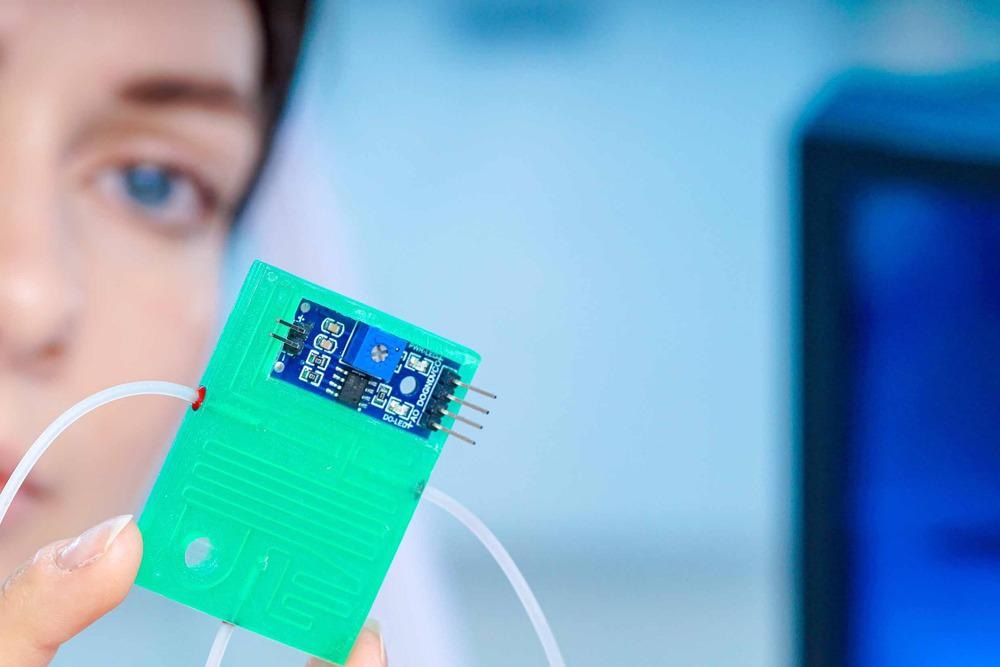Modeling, evaluation, and fabrication of silver resonant nanoparticles for use in biomolecule sensing were examined in a paper available as a pre-proof in the journal Photonics and Nanostructures - Fundamentals and Applications.

Study: Design and performance simulation of a highly sensitive nano-biosensor based on a realistic array of plasmonic synthesized nanostructures. Image Credit: luchschenF/Shutterstock.com
Need of Novel Biosensors
Considering the significance of early identification in therapy, existing screening tests involve multiple procedures and, in most cases, sophisticated scientific instruments and skilled personnel who are not constantly accessible.
As a result, innovative low-cost and mobile equipment that can quickly identify target molecules without specialists, particularly for point-of-care applications, is preferred.
Scientists have created nano- and micro-biosensors that can identify biomolecules very quickly to attain these objectives.
Effectiveness of Plasmon Nanoparticles
In plasmon nanoparticles (NPs), electrons can be stimulated into in-phase oscillations, which is limited by the size of the nanoparticle.
In NPs that are straightforwardly stimulated by electromagnetic waves, non-propagating phases, known as Localized Surface Plasmon (LSPs), develop.
The dispersion and permeability cross-sections are used to express their resonant frequency.
The form, volume, and substance of the nanoparticles, as well as their dielectric surroundings, determine the LSP resonances (LSPRs).
Gold (Au) and silver (Ag) NPs (i.e., SNPs) as rare metals with high electrical conductivity have also been studied for their plasmonic capabilities.
Due to their superior optical and photonic capabilities, plasmonic nanomaterial offer a wide spectrum of uses in biomedicine.
Researchers have produced highly predictable volume, structure, and characteristics of plasmonic nanoparticles using strong evaluation techniques and more sophisticated fabrication techniques.
Preference of SNPs over Silver Nanoparticles
Despite Au NPs' exceptional chemical durability, rendering them one of most researched precious metals for detecting technologies, Ag has several advantages over Au in terms of ground-enhanced spectrometric detectors.
Brighter extinction range, greater absorption ratio and dispersion to elimination rate, and extended area amplification are most of these characteristics.
Both Au NPs and SNPs are particularly responsive to variations in the localized index of refraction (RI), which depends on the analyte's intensity, in LSPR-based detectors.
SNPs have a lower plasmonic range than Au as well as other metallic NPs, making it attractive choices for LSPR-based detectors that correctly monitor the LSPR change.
Industrial Utilization
Numerous medical uses for nanomaterial plasmon substances have been developed in recent times.
Due to graphene's enormous contact surface, refractive attributes, chemical and temperature durability, and biocompatibility, combining graphene-based substances as two-dimensional substances with metallic NPs in LSPR detectors potentially improve the scanner's consistency, compliance, and responsiveness.
Regardless of the material solubilizing on the metal area or the area of metallic NPs will have a considerable impact on the placement and amplitude of the resonating point.
As a result, designing a nano-biosensor requires monitoring the maximum frequency change or strength change of plasmon metallic nanomaterial in a given frequency spectrum.
SPR-based biomarkers have larger reactive protocols than LSPR-based biosensors, yet LSPR offers certain significant benefits. For example, LSPR possesses linearity, is less susceptible to thermal effects, and requires little monitoring, but SPR has drawbacks.
It is therefore critical to improve the responsiveness of LSPR-based detectors.
Research Findings
The stimulation of plasmon sonorities of cylindrical SNPs was confirmed in the latest study.
UV-visible (UV-vis) spectroscopic study, dynamic light scattering (DLS), and field emission scanning electron microscopy (FESEM) methods were used to examine SNPs produced using polyethylenimine (PEI) as a reduction and binding agent using a thermal decomposition approach.
Based on the acquired SEM and DLS data, scattering cross-sections of 10x10 linked SNPs with various sizes were estimated and analyzed.
The LSPR peak displacement and responsiveness of a 30-nm SNP optimal size array were contrasted to a practical array consisting of a 34-nm uniform size array and non-uniform size NPs.
Their plasmonic resonant frequencies were particularly sensitive to RI disturbances in the surroundings.
In short, the resonance peak was displaced by a minor change in the RI of the aqueous media surrounding SNPs, according to the scattering spectra confirming the effectiveness of biosensors.
Nanosensors: The Future Nano-Energy Harvesting Element
Reference
Saboor, F. H., Hadian-Ghazvini, S., & Heidarzadeh, H. (2022). Design and performance simulation of a highly sensitive nano-biosensor based on a realistic array of plasmonic synthesized nanostructures. Photonics and Nanostructures - Fundamentals and Applications. Available at: https://www.sciencedirect.com/science/article/pii/S1569441022000013?via%3Dihub
Disclaimer: The views expressed here are those of the author expressed in their private capacity and do not necessarily represent the views of AZoM.com Limited T/A AZoNetwork the owner and operator of this website. This disclaimer forms part of the Terms and conditions of use of this website.